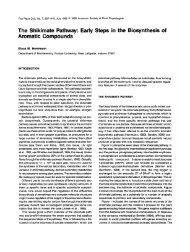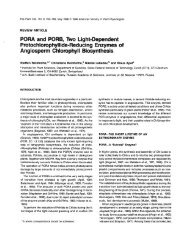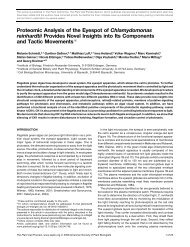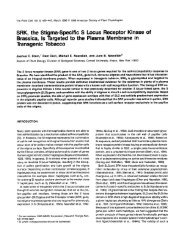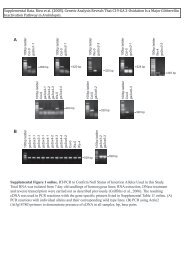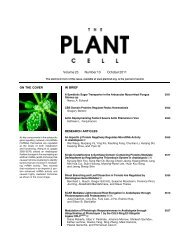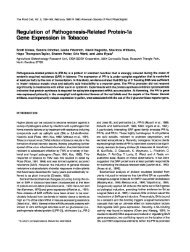The Angiosperm Gibberellin-GID1-DELLA Growth ... - The Plant Cell
The Angiosperm Gibberellin-GID1-DELLA Growth ... - The Plant Cell
The Angiosperm Gibberellin-GID1-DELLA Growth ... - The Plant Cell
Create successful ePaper yourself
Turn your PDF publications into a flip-book with our unique Google optimized e-Paper software.
8 of 12 <strong>The</strong> <strong>Plant</strong> <strong>Cell</strong><br />
characteristic of the constitutive ethylene response phenotype<br />
conferred by ctr1 loss-of-function alleles (Achard et al., 2007b).<br />
Further analysis indicates that ethylene likely affects <strong>DELLA</strong>s<br />
downstream of the EIN3 transcriptional regulator and delays<br />
flowering by repressing the activity of floral meristem identity<br />
genes (LEAFY and SUPPRESSOR OF OVEREXPRESSION OF<br />
CONSTANS1; Achard et al., 2007b). <strong>The</strong>se observations identify<br />
the GA-<strong>GID1</strong>-<strong>DELLA</strong> mechanism as a previously unknown<br />
bridge between the ethylene signaling pathway and floral meristem<br />
identity genes in the regulation of the transition between<br />
vegetative to reproductive growth, probably providing a mechanism<br />
via which environmental stress regulates that transition.<br />
Several studies have directly implicated the GA-<strong>GID1</strong>-<strong>DELLA</strong><br />
mechanism in regulating the response of plants to environmental<br />
stress. For example, high salinity slows the growth of plants.<br />
Studies with <strong>DELLA</strong>-deficient Arabidopsis mutants showed that<br />
salt slows growth via a partially <strong>DELLA</strong>-dependent mechanism<br />
(Achard et al., 2006). Further studies revealed that salt causes a<br />
reduction in in planta bioactive GA levels (Achard et al., 2006) and<br />
that this reduction can be explained, at least in part, by activation<br />
of genes encoding GA-2oxidase, an enzyme that deactivates<br />
bioactive GAs by addition of a hydroxyl group to the 2C position<br />
(Figure 1A; Magome et al., 2008). Thus, salt inhibits plant growth<br />
by reducing bioactive GA abundance, in turn causing accumulation<br />
of <strong>DELLA</strong>s and consequent growth inhibition. Saltactivated<br />
<strong>DELLA</strong>-dependent growth inhibition presumably has<br />
adaptive significance because plants lacking <strong>DELLA</strong>s are more<br />
susceptible, whereas plants in which <strong>DELLA</strong>s accumulate (e.g.,<br />
ga1-3) are more resistant to the lethal effects of extreme salt<br />
(Achard et al., 2006). <strong>The</strong>se observations indicate that the GA-<br />
<strong>GID1</strong>-<strong>DELLA</strong> mechanism provides plants with a means of regulating<br />
growth appropriate to environmental conditions, enabling<br />
a slowing of growth and reduced energetic commitment during<br />
periods of environmental adversity. Achard et al. (2008a) identified<br />
a reduction in reactive oxygen species levels as a possible<br />
mechanism for the restraint of growth and the concomitant<br />
promotion of survival of adverse salinity.<br />
A link between ethylene and the GA-<strong>GID1</strong>-<strong>DELLA</strong> mechanism<br />
has also been implicated in the growth responses of rice to<br />
flooding. Flood-tolerant rice survives temporary submergence<br />
via a transient inhibition of growth and carbohydrate consumption<br />
that is controlled by an ethylene-responsive factor ERF-type<br />
transcription factor encoded by the Sub1A gene. Submergence<br />
causes ethylene production and the consequent activation of<br />
Sub1A. In turn, Sub1A inhibits elongation growth by causing<br />
increased accumulation of the rice <strong>DELLA</strong> SLR1 and of a related<br />
protein, SLRL1 (Fukao and Bailey-Serres, 2008). SLRL1 is a<br />
protein that inhibits growth but lacks functional domains I and II<br />
(see above) and thus inhibits growth in a GA-resistant fashion.<br />
<strong>The</strong>refore, SLRL1 is functionally analogous to the mutant <strong>DELLA</strong><br />
proteins encoded by the mutant gai, D8-1, D8-2023, and Rht-<br />
B1b alleles described above and is a protein that rice has<br />
recruited to function in flooding response. Thus, as shown<br />
previously in Arabidopsis (Achard et al., 2003), ethylene can<br />
inhibit rice growth using a GA-<strong>GID1</strong>-<strong>DELLA</strong>–dependent mechanism<br />
(via SLR1) and additionally using a <strong>DELLA</strong>-related non-GA<br />
opposable growth inhibitory protein (SLRL1). Activation of SLR1<br />
and SLRL1 by Sub1A suppresses energy-consuming processes,<br />
resulting in reduced carbohydrate consumption and inhibited<br />
growth in response to flooding in rice (Fukao and Bailey-Serres,<br />
2008), just as <strong>DELLA</strong>s inhibit growth in response to salt stress in<br />
Arabidopsis (Achard et al., 2006). <strong>The</strong>se observations suggest<br />
that the GA-<strong>GID1</strong>-<strong>DELLA</strong> mechanism provides a general mechanism<br />
for inhibition of growth and associated resource consumption<br />
in response to environmental adversity.<br />
<strong>The</strong> likelihood that the GA-<strong>GID1</strong>-<strong>DELLA</strong> mechanism is indeed<br />
a general mechanism for modulating growth response to the<br />
environment is increased by recent discoveries that it regulates<br />
growth in response to change in a wide variety of environmental<br />
variables. For example, the effects of cold temperatures on plant<br />
growth signaled by the cold-induced CBF1 factor-dependent<br />
pathway are mediated via effects on GA metabolism (and consequently<br />
on <strong>DELLA</strong>s; Achard et al., 2008b), and growth and<br />
developmental responses to phosphate starvation are also<br />
modulated by the GA-<strong>GID1</strong>-<strong>DELLA</strong> pathway (Jiang et al., 2007).<br />
An unexpected recent development has been the discovery<br />
that the GA-<strong>GID1</strong>-<strong>DELLA</strong> mechanism plays a role in the regulation<br />
of plant–pathogen interactions. Studies of the pathogen<br />
responses of <strong>DELLA</strong>-deficient Arabidopsis plants showed that<br />
<strong>DELLA</strong> accumulation differentially affects response to different<br />
classes of pathogen. Thus, presence of <strong>DELLA</strong>s is associated<br />
with susceptibility to virulent biotrophs and with resistance to<br />
necrotrophs, properties that are related to an effect of the GA-<br />
<strong>GID1</strong>-<strong>DELLA</strong> pathway on the balance between jasmonic acid<br />
and salicylic acid signaling (Navarro et al., 2008). Although<br />
concordant with previous examples of the GA-<strong>GID1</strong>-<strong>DELLA</strong><br />
mechanism acting as a mediating bridge between different<br />
signaling pathways, these observations were unexpected because<br />
they represent identification of a GA-<strong>GID1</strong>-<strong>DELLA</strong>–regulated<br />
phenomenon that is not strictly growth related (the<br />
pathogenicity assays used in these experiments involved relatively<br />
mature leaves that were no longer in the growing phase). It<br />
is possible that there are additional non-growth aspects of GA-<br />
<strong>GID1</strong>-<strong>DELLA</strong> biology that are yet to be discovered.<br />
DOES THE GA-<strong>GID1</strong>-<strong>DELLA</strong> MECHANISM HAVE<br />
ADAPTIVE SIGNIFICANCE?<br />
Given that the GA-<strong>GID1</strong>-<strong>DELLA</strong> mechanism plays such a prominent<br />
role in the response of plants to environmental variables, it<br />
might be expected that possession of this mechanism is selectively<br />
advantageous and that variant forms of it might have<br />
adaptive significance. Recent studies monitored the effects of<br />
artificial selection on an experimental wheat population segregating<br />
for Rht-B1a and Rht-B1b (wheat <strong>DELLA</strong>-encoding alleles<br />
conferring tall and dwarf plant phenotypes, respectively; Peng<br />
et al., 1999a; Raquin et al., 2008). Mean plant height increased<br />
steadily with number of generations post the founder population<br />
generation, as did the relative frequency of the RhtB1a allele,<br />
indicating that Rht-B1a was under strong positive selection<br />
throughout the 17 generations of the experiment (Raquin et al.,<br />
2008). At first sight this may seem paradoxical given the welldocumented<br />
increases in grain yield conferred by Rht-B1b (see<br />
above), the very increases that were responsible for the use of<br />
the Rht-B1b allele in green revolution wheat varieties. However,




